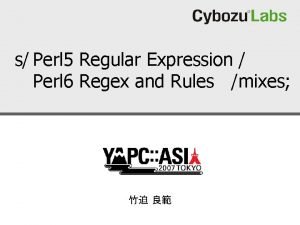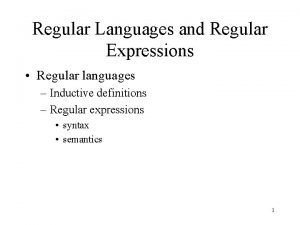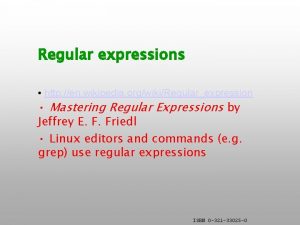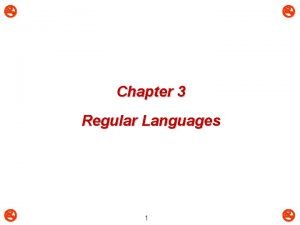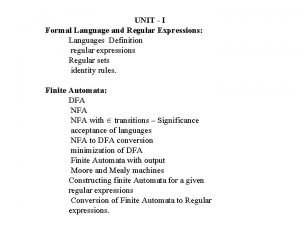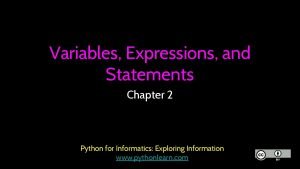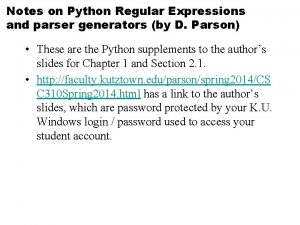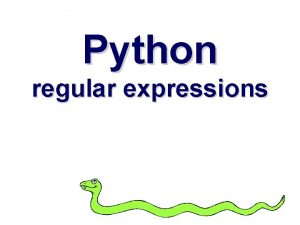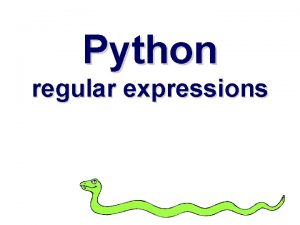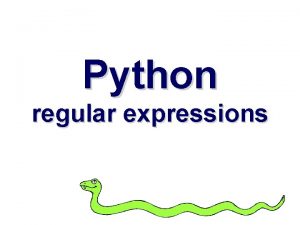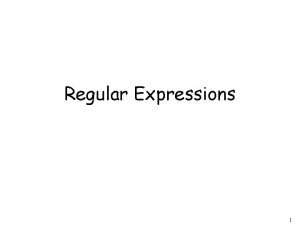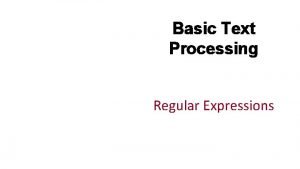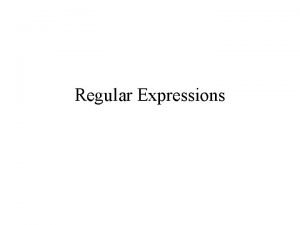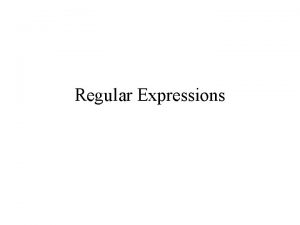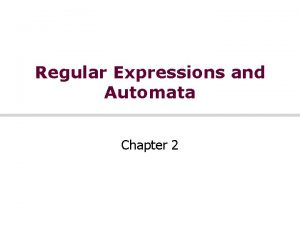Python regular expressions Some people when confronted with

















![The pattern ([bcdfghjklmnpqrstvwxyz]+)(w+) The pattern ([bcdfghjklmnpqrstvwxyz]+)(w+)](https://slidetodoc.com/presentation_image/11f352aed2f5e63b35e23e73708eff3c/image-18.jpg)
![piglatin. py import re pat = ‘([bcdfghjklmnpqrstvwxyz]+)(w+)’ cpat = re. compile(pat) def piglatin(string): return piglatin. py import re pat = ‘([bcdfghjklmnpqrstvwxyz]+)(w+)’ cpat = re. compile(pat) def piglatin(string): return](https://slidetodoc.com/presentation_image/11f352aed2f5e63b35e23e73708eff3c/image-19.jpg)

- Slides: 20

Python regular expressions


“Some people, when confronted with a problem, think ‘I know, I'll use regular expressions. ’ Now they have two problems. ” -- Jamie Zawinski http: //www. jwz. org/

Regular Expressions · Regular expressions are a powerful string manipulation tool · All modern languages have similar library packages for regular expressions · Use regular expressions to: • Search a string (search and match) • Replace parts of a string (sub) • Break strings into smaller pieces (split)

Python’s Regular Expression Syntax · Most characters match themselves The regular expression “test” matches the string ‘test’, and only that string · [x] matches any one of a list of characters “[abc]” matches ‘a’, ‘b’, or ‘c’ · [^x] matches any one character that is not included in x “[^abc]” matches any single character except ‘a’, ’b’, or ‘c’

Python’s Regular Expression Syntax · “. ” matches any single character · Parentheses can be used for grouping “(abc)+” matches ’abc’, ‘abcabcabc’, etc. · x|y matches x or y “this|that” matches ‘this’ and ‘that’, but not ‘thisthat’.

Python’s. Regular Expression Syntax · x* matches zero or more x’s “a*” matches ’’, ’aa’, etc. · x+ matches one or more x’s “a+” matches ’a’, ’aaa’, etc. · x? matches zero or one x’s “a? ” matches ’’ or ’a’ · x{m, n} matches i x‘s, where m<i< n “a{2, 3}” matches ’aa’ or ’aaa’

Regular Expression Syntax · “d” matches any digit; “D” any non-digit · “s” matches any whitespace character; “S” any non-whitespace character · “w” matches any alphanumeric character; “W” any non-alphanumeric character · “^” matches the beginning of the string; “$” the end of the string · “b” matches a word boundary; “B” matches a character that is not a word boundary

Search and Match · The two basic functions are re. search and re. match • Search looks for a pattern anywhere in a string • Match looks for a match staring at the beginning · Both return None (logical false) if the pattern isn’t found a “match object” instance if it is >>> import re >>> pat = "a*b” >>> re. search(pat, "fooaaabcde") <_sre. SRE_Match object at 0 x 809 c 0> >>> re. match(pat, "fooaaabcde") >>>

Q: What’s a match object? · A: an instance of the match class with the details of the match result >>> r 1 = re. search("a*b", "fooaaabcde") >>> r 1. group() # group returns string matched 'aaab' >>> r 1. start() # index of the match start 3 >>> r 1. end() # index of the match end 7 >>> r 1. span() # tuple of (start, end) (3, 7)

What got matched? · Here’s a pattern to match simple email addresses w+@(w+. )+(com|org|net|edu) >>> pat 1 = "w+@(w+. )+(com|org|net|edu)" >>> r 1 = re. match(pat, "finin@cs. umbc. edu") >>> r 1. group() 'finin@cs. umbc. edu’ · We might want to extract the pattern parts, like the email name and host

What got matched? · We can put parentheses around groups we want to be able to reference >>> pat 2 = "(w+)@((w+. )+(com|org|net|edu))" >>> r 2 = re. match(pat 2, "finin@cs. umbc. edu") >>> r 2. group(1) 'finin' >>> r 2. group(2) 'cs. umbc. edu' >>> r 2. groups() ('finin', 'cs. umbc. edu', 'umbc. ', 'edu’) · Note that the ‘groups’ are numbered in a preorder traversal of the forest

What got matched? · We can ‘label’ the groups as well… >>> pat 3 ="(? P<name>w+)@(? P<host>(w+. )+(com|org|net| edu))" >>> r 3 = re. match(pat 3, "finin@cs. umbc. edu") >>> r 3. group('name') 'finin' >>> r 3. group('host') 'cs. umbc. edu’ · And reference the matching parts by the labels

More re functions · re. split() is like split but can use patterns >>> re. split("W+", “This. . . is a test, short and sweet, of split(). ”) ['This', 'a', 'test', 'short’, 'and', 'sweet', 'of', 'split’, ‘’] · re. substitutes one string for a pattern >>> re. sub('(blue|white|red)', 'black', 'blue socks and red shoes') 'black socks and black shoes’ · re. findall() finds al matches >>> re. findall("d+”, "12 dogs, 11 cats, 1 egg") ['12', '11', ’ 1’]

Compiling regular expressions · If you plan to use a re pattern more than once, compile it to a re object · Python produces a special data structure that speeds up matching >>> capt 3 = re. compile(pat 3) >>> cpat 3 <_sre. SRE_Pattern object at 0 x 2 d 9 c 0> >>> r 3 = cpat 3. search("finin@cs. umbc. edu") >>> r 3 <_sre. SRE_Match object at 0 x 895 a 0> >>> r 3. group() 'finin@cs. umbc. edu'

Pattern object methods Pattern objects have methods that parallel the re functions (e. g. , match, search, split, findall, sub), e. g. : >>> p 1 = re. compile("w+@w+. +com|org|net|edu") email address >>> p 1. match("steve@apple. com"). group(0) 'steve@apple. com' >>> p 1. search(”Email steve@apple. com today. "). group(0) 'steve@apple. com’ >>> p 1. findall("Email steve@apple. com and bill@msft. com now. ") ['steve@apple. com', 'bill@msft. com’] sentence boundary >>> p 2 = re. compile("[. ? !]+s+") >>> p 2. split("Tired? Go to bed! Now!! ") ['Tired', 'Go to bed', 'Now', ’ ']

Example: pig latin · Rules • If word starts with consonant(s) — Move them to the end, append “ay” • Else word starts with vowel(s) — Keep as is, but add “zay” • How might we do this? http: //cs. umbc. edu/courses/331/current/code/python/pig. py
![The pattern bcdfghjklmnpqrstvwxyzw The pattern ([bcdfghjklmnpqrstvwxyz]+)(w+)](https://slidetodoc.com/presentation_image/11f352aed2f5e63b35e23e73708eff3c/image-18.jpg)
The pattern ([bcdfghjklmnpqrstvwxyz]+)(w+)
![piglatin py import re pat bcdfghjklmnpqrstvwxyzw cpat re compilepat def piglatinstring return piglatin. py import re pat = ‘([bcdfghjklmnpqrstvwxyz]+)(w+)’ cpat = re. compile(pat) def piglatin(string): return](https://slidetodoc.com/presentation_image/11f352aed2f5e63b35e23e73708eff3c/image-19.jpg)
piglatin. py import re pat = ‘([bcdfghjklmnpqrstvwxyz]+)(w+)’ cpat = re. compile(pat) def piglatin(string): return " ". join( [piglatin 1(w) for w in string. split()] )

piglatin. py def piglatin 1(word): """Returns the pig latin form of a word. e. g. : piglatin 1("dog”) => "ogday". """ match = cpat. match(word) if match: consonants = match. group(1) rest = match. group(2) return rest + consonents + “ay” else: return word + "zay"
 Moses 1 verse 39
Moses 1 verse 39 Paul confronted peter to his face
Paul confronted peter to his face Xkcd regex problems
Xkcd regex problems Simplifying regular expressions
Simplifying regular expressions Perl 5 regular expression
Perl 5 regular expression Inductive definition of regular expressions
Inductive definition of regular expressions Regular expressions wikipedia
Regular expressions wikipedia Algebraic properties of regular expression
Algebraic properties of regular expression I formal
I formal Primitive regular expressions
Primitive regular expressions Regular expressions
Regular expressions Every linear grammar generates a regular language
Every linear grammar generates a regular language Variables expressions and statements in python
Variables expressions and statements in python Parser generator python
Parser generator python Mention 5 expressions of compliment
Mention 5 expressions of compliment Leave taking examples
Leave taking examples Sometimes you win some
Sometimes you win some They say it only takes a little faith to move a mountain
They say it only takes a little faith to move a mountain Ice cream is countable
Ice cream is countable Contact and non contact forces
Contact and non contact forces Fire and ice diamante poem
Fire and ice diamante poem




